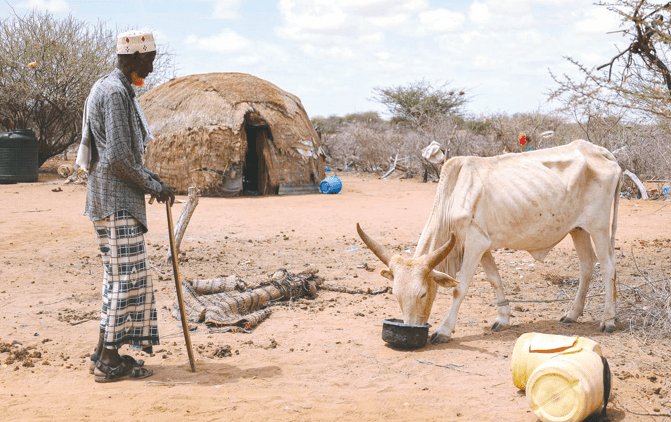New world atlas a timely tool for building climate resilience

In the past four years, Kenya and the Horn of Africa experienced the worst drought in four decades, with its devastating repercussions still being felt to date. The vast region hosts many pastoral and agro-pastoral communities dependent on livestock raising and production. Parts of the region are characterised by arid and semi-arid lands (ASALs) that are prone to recurrent droughts and severe climatic shocks.
While resilience-building efforts across the region have made important progress, the frequency and severity of droughts in recent years, combined with the exceptionally prolonged nature of the 2019-2023 drought, have made it harder for families to recover from the shock.
Defining resilience
Recurrent drought was a prominent subject discussed during the 16th Session of the Conference of Parties to the United Nations Convention on Combating Desertification (UNCCD), known as COP16 in Riyadh, Saudi Arabia, which ended last Friday.
That’s why the drought-ravaged regions of Africa, will warmly welcome the World Drought Atlas launched during UNCCD COP16.
It is a timely and important policymaker’s tool illustrating the complex, systemic nature of drought with the latest science and policy solutions to underpin proactive and inclusive water resilience strategies.
The World Drought Atlas jointly developed by the UNCCD and the European Commission allows policymakers to access the latest science for managing drought risks. It also includes case studies that illustrate the latest drought management solutions.
Drought in the context of growing resource scarcity, especially over the availability of water and associated livelihood sources linked to climate change, has seen an increase in communal and resource-based conflicts over cattle, crowding at drying water points for livestock and other limited resources.
The Horn of Africa region has also been negatively affected by the deteriorating macroeconomic conditions and trade disruptions related to the Russia-Ukraine war, with households still reeling from the lingering effects of the COVID-19 pandemic on livelihoods and income sources.
The disruptive potential of drought impacts goes beyond agriculture and water supply, to almost impact energy supply, inland navigation and ecosystems, among other sectors.
On Resilience Day at UNCCD COP16, participants devoted their discussions to desertification, land degradation and drought, sand and dust storms, and water scarcity with integrated land solutions.
Resilience against drought means many things, from harvesting rainwater, tree planting, clarity on land ownership and restoring hope to people displaced by climate impacts. The discussions showed how these are connected.
African Union (AU) Commission’s Viola Otieno noted that early warning systems can be made more actionable to enhance resilience, observing the time lag between early warning and government action, since governments may require time to pass legislation.
Land restoration
Otieno observed that half of all African countries do not have a drought strategy and called for addressing systemic root causes, saying the AU Commission will soon launch a new Drought Early Warning and Monitoring Service.
In 2024, she explained, the Southern African region received its largest-ever share allocation for anticipatory action on drought. However, governments are managing competing priorities and do not prioritise anticipatory action.
“World leaders and citizens should unite to accelerate the restoration of degraded land through regenerative agriculture and water harvesting, which will create jobs and promote more resilient food value chains,” the World Food Programme (WFP) Global Partner Countries Director Abdallah Alwardat emphasised.
The WFP Director added that drought and desertification are not only environmental crises but also contribute to hunger, poverty and displacement. He said enhancing early warning systems will complement land restoration efforts.
Chad’s Ministry of Environment and National Agency on the Great Green Wall Director, Kodou Choukou Tidjani drew the UNCCD’s attention to Chad’s desertification crisis and population displacement, including the influx of refugees from Sudan and the Central African Republic.
“The people of the Sahel have no means of subsistence and, therefore, are joining armed rebel groups such as Boko Haram,” he said.
Drought risks
Tidjani highlighted national initiatives to counter the advance of the desert by 2.5km every five years, such as land allocation for farming and the National Tree Week, when every citizen plants at least one tree.
World Meteorological Organisation and Global Water Partnership’s Valentin Aich observed that the World Drought Atlas is a tool that can show countries how drought should be understood, not as a “single-track” focus on agriculture, but as a complex disaster to be tackled on different fronts.
CIMA Research Foundation of Italy’s Tessa Maurer who moderated the session on drought risks and resilience and the launch of the Atlas, said it provides key insights.
First, that biodiversity is a factor that can mitigate drought. Second, drought events have spurred trans-boundary river basin agreements. Third, the Atlas supports an ever-evolving response where there are different entry points to the problem, and where those entry points can help support each other.
European Commission Director-General for the Environment Cristina de Avila said the European Union (EU) is developing policies to inform a water resilience strategy.
On the scope for applying nature-based solutions (NBS) to alleviate drought, de Avila referred to the EU’s Nature Restoration Law which entered into force this year.
UNCCD Intergovernmental Working Group on Drought’s Patrick Augenstein, said the most powerful contribution of the World Drought Atlas is that it reframes drought not as a natural phenomenon, but one that is connected to human practices.














